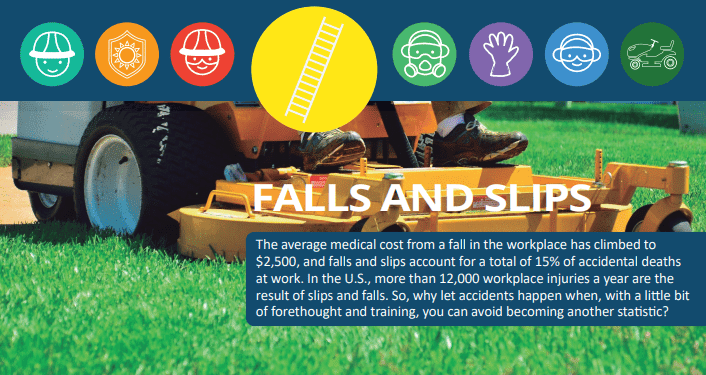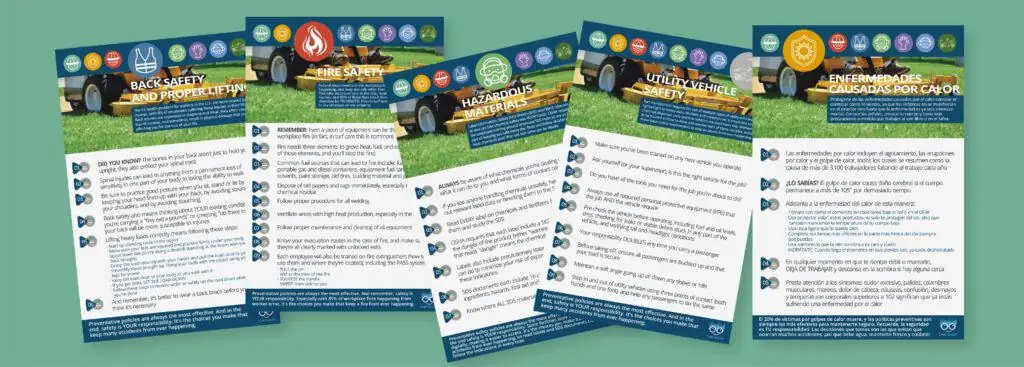
Scientifically speaking, slips happen when there is not enough friction (or traction) between the area you’re walking on and your feet (or shoes or boots). Trips, on the other hand, are the loss of balance caused by your foot hitting against an object you weren’t prepared for.
People trip at work for many reasons, including messy and untidy walkways, inadequate lighting, unprotected installation wires and cables, unattended, opened storage units and drawers, and uneven rugs or carpet floors.
Some general recommendations for preventing slips and trips include:
Falls
Falls are possible in absolutely any work setting and as a product of many different things. That said, many culprits typically making more falls happen include uneven or untidy walkways or work surfaces, floor and wall openings, unguarded and exposed edges, inadequately-used fall protection, slippery areas, and poorly-positioned ladders.
Generally, it’s recommended that you should maintain situational awareness wherever you are and walk at the proper pace, taking into account the kind of surface that you’re walking on as well as the complexities of the task you’re performing. While walking, be sure to use wide turns to see more of what’s ahead of you, utilize safety handrails while using the stairs, and walk with both of your feet pointed outwards a little bit.
How to prevent slips and falls
Study these rules and tips to keep you and your coworkers safe, and to always be on the lookout for fall hazards.
· Ladders used in an improper and unsafe manner
· Uncovered hoses, cables, and extension cords
· Grease and oil
· Sand
· Hoses and extension cords Standing water
· Lack of traction (like with grass clippings on a step pad)
Additional guidelines for preventing slips and falls
Workplace-related falls average around $2,500 per accident in terms of medical costs incurred later. And about 15% of accidental deaths at the workplace are caused by slips and falls. Workplace injuries for slips and falls nationwide average over 12,000 each year.
Safety policies that emphasize preventative measures and policies have the most impact. Safety is the responsibility of each and every worker. Many accidents can be avoided by each worker being careful, alert, and conscientious in their work and housekeeping duties.
Bonus section: using ladders safely
To ensure ladders are used safely, each worker should be instructed as to how to pick out, look over, and use each and every ladder used at the workplace.
Selecting the right kind of ladder
Not all ladders are built for the same tasks. It’s important to know the types of ladders at the workplace and what tasks can be accomplished with each type of ladder.
A few of the common kinds of ladders include step ladders, extension ladders and step-stools.
Ladder Height: You should consider the ladder height that is necessary for the job. Underestimating the required height and picking a ladder that is too short for the job is a common workplace mistake. This can lead to bad standing on the highest two steps on a step ladder or overreaching on a ladder that’s too short for the task. Note that ladders placed against a building should be at the very least three feet (about two rungs) higher than whatever building the ladder is placed against.
Body Weight: You should keep note of your body weight when using any ladder. All ladders plainly spell out their weight capacities. You should ensure that your weight and the weight of your tools do not exceed the maximum weight that the ladder can carry.
Material of Ladder: The ladder’s material is also an important factor to keep in mind. Ladders are typically made of metal, fiberglass, and wood. Metal ladders should be treated with extra care, as they have the capability of arcing and transmitting electrical if exposed to an electrical energy source.
Inspecting ladders
Ladders should be inspected before each and every use. Ladders with deficiencies and faults cannot be used. Everyone should be properly trained on inspecting ladders for any problems before using them.
More specifically, pay attention to:
Precautions for using ladders safely
Remember: to use a ladder safely, always start with the PPE you need (namely gloves), face the ladder head-on, use three points of contact at all times, and have a coworker spot you.
In the end, safety is YOUR responsibility. And with these precautions, it will come that much more naturally to you.
